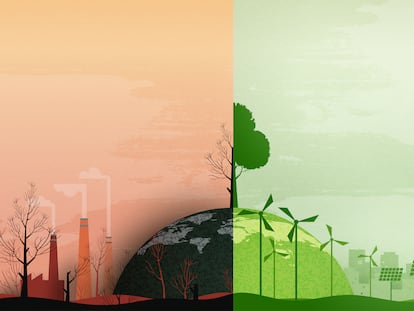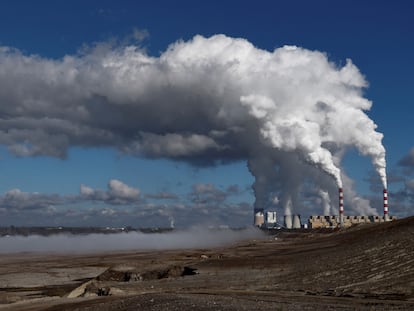How to regulate ‘the Wild West’ of carbon markets in Latin America
Colombia — the country with the most carbon credits issued — has a case before the Constitutional Court. Meanwhile, Chile is preparing more transparent regulations, Brazil wants to approve an emissions trading system before the COP28 and Mexico is leading the way


In July 2022, the Pirá Paraná Indigenous Council — located in the Colombian Amazon — went to court to seek the annulment of a contract. A couple of years before they took this legal route, the Masbosques Corporation — along with three other companies — had arrived in the tribe’s territory to develop a carbon credit project. However, during the community’s process to authorize it, several of their rights were violated, including the right to self-governance.
The Indigenous Council notes that the person who signed the document with Masbosques (which literally translates to “more forests”) wasn’t authorized to do so. The legal representative had left office two weeks before the contract’s signing, hence, the project was never actually approved by the relevant Indigenous authorities.
This past April 28 — after being rejected twice — the petition to annul was accepted by the Constitutional Court of Colombia. This could set a new precedent in the development of the country’s carbon market. “It’s an opportunity for the Court — which has been a guarantor of the rights of Indigenous peoples — to agree with them,” says Silvia Gómez, executive director of the Gaia Amazonas Foundation. “It’s also an opportunity to have a debate about how these markets are functioning in the country. What rules are they operating under?”
Both in Colombia and Latin America, some carbon markets have gained popularity, while others have garnered a bad reputation. On the one hand, they represent an opportunity to avoid more greenhouse gas emissions, while also opening up the possibility for local populations to participate in a voluntary carbon market that — according to Ecosystem Marketplace — has already surpassed $2 billion. On the other hand, there have been many questions about how carbon markets are being implemented.
A study published in August of this year by Science analyzed 27 forest-based carbon projects in six countries, including Peru and Colombia. It revealed that these initiatives didn’t meet the projections made by the development companies when it came to combating deforestation. 68% of the carbon credits analyzed didn’t reduce deforestation at all, while only 6% could be linked to reductions.

But the doubts don’t stop there. As happened with the project in Pirá Paraná territory, some of these initiatives have been accused of violating the rights of the communities, preventing their participation and not properly overseeing the distribution of benefits. The situation in Colombia has even led Minister of the Environment Susana Muhamad to refer to this voluntary market as “the Wild West.”
In the world of carbon pricing instruments, there are two markets. There’s the voluntary one, in which companies choose to pay for carbon credits to reduce their emissions. And then, there’s the regulated carbon market — also known as emissions trading systems (ETS) — in which governments set emissions caps on companies or whole sectors. For instance, a government can say that each company can emit a maximum of ten tons of carbon. If company A manages to reduce its emissions and only generates five, while company B goes too far and generates 15, there may be a market for the former to sell the emissions quota to the latter. Or, the company that has broken the cap can pay compensation by supporting a reforestation project.
A few days before the Climate Change Summit (COP28) begins in Abu Dhabi, EL PAÍS analyzed how the carbon markets in some Latin American countries are developing.
Colombia: a growing market with some lingering doubts
In the region, Colombia has been a kind of leader in promoting carbon markets. Giovanni Pabón — director of Energy at the Transforma think tank — explains that the government encouraged the voluntary carbon market by imposing a carbon tax during the 2016 tax reform. By 2017, each company could either choose to pay the tax — 15,000 pesos for each ton of CO2 emitted ($3.80) — or compensate for its emissions through a carbon credits project. “[The country] gave a pro-market signal. As the supply of carbon credits already existed, what was created was demand.”
Currently, the carbon tax is about $4.50 a ton, depending on the type of fossil fuel. However, being a leader also means being a laboratory mouse. The voluntary carbon market in Colombia has received several criticisms. The platform on which all initiatives are supposed to be registered — Renare — is currently down, meaning that they cannot be properly monitored.
Sebastián Lema — the director of carbon markets at the Center for Clean Air Policy (CCAP) — explains that there also may be a conflict of interest within the Colombian system. Everyone in the exchange market — the developers, verifiers and certifiers — are private entities. Hence, they seek to “generate the greatest number of credits.” Therefore, in the eyes of some experts, although it’s technically a voluntary market, there should be clearer rules. One of the signals that could lead to fairer agreements, Lema suggests, is to make public how much communities actually receive for hosting carbon projects — something that’s currently not transparent, as it’s assumed that the agreements are made between private parties.
In addition to the voluntary market, the government is also expected to create an ETS — an emissions trading system — since, according to the 2018 Climate Change Law, the guidelines to move this regulated market forward should have been completed back in 2021.
Chile
Rodrigo Bórquez — the project manager at Climate Action Teams — says that the path Chile is taking is very similar to Colombia’s. “We’re differentiated by the timelines, the institutional infrastructure and some designs,” he explains. In 2017, the government of Chile imposed a tax on four pollutants — including CO2 — at a rate of $5 per ton. Additionally, in 2018, the possibility of offsetting the tax was established.
Unlike Colombia, Chile set out to create a more robust monitoring, reporting and verification system. Through Law 21.210, all carbon projects must be located within Chile, while these projects and their methodologies must be approved or developed by the Ministry of the Environment.
“In Chile, we don’t have severe conflicts over the carbon market,” the expert notes. Firstly, because many of the credits don’t come from the forestry sector, but from the energy sector — it’s more fair. And secondly — as Bórquez emphasizes — in Chile, “the field is being created, with proper rules to the game. [Only afterward] are the players joining.” As in Colombia, an ETS is also in the cards.
Brazil
Despite being the country with the largest part of the Amazon rainforest, Brazil hasn’t been encouraged to impose a carbon tax and or set up a voluntary carbon market. However, this doesn’t mean that the initiatives don’t exist. Currently, says Camilo Trujillo, a technical analyst with the International Emissions Trading Association (IETA) for Latin America, Brazil is the country with the highest number of registered carbon projects (184), followed by Colombia (154) and Mexico (152). However, the fact that this voluntary market hasn’t been encouraged can also explain why Colombia — despite being a much smaller country — is in first place when it comes to the number of carbon credits issued.
“There’s currently a legislative proposal to create an emissions trading system in Brazil, which is expected to be approved before the COP28 in Dubai,” says Walter de Simoni, from the Institute for Climate and Society. But the good news has a catch: agriculture and livestock won’t be included in this system. That is, in a country where the largest amount of emissions comes from deforestation and land use, emissions from these sectors will not be limited.
Mexico
Another leader in the region is Mexico. Not only did it implement a carbon tax in 2014: it’s currently the only country in the region that has an ETS in place. Between 2020 and 2022, the country developed a pilot phase, which placed emissions caps on 300 entities that together represent almost 37% of national emissions, according to an IETA report.
As of this past January, the Mexican Emissions Trading System (SCE) was supposed to begin operating properly. “However, the main rules for this phase still haven’t been published,” the report also notes, clarifying that the government of Mexico said it was going to make them public between 2024 and 2025.
The carbon market in Mexico has also had several challenges, as reported by EL PAÍS. For instance, the companies that are obliged to reduce emissions either don’t know that they have to, or don’t have the specialized personnel necessary to reduce emissions. Additionally, and as is occurring in Colombia, the local communities where emissions reduction projects are installed don’t always receive fair payment, nor are they always consulted about the process.
Trujillo — from the International Emissions Trading Association — says that these markets are still an evolving mechanism, especially in Latin America. “And just as they’ve had positive results, there are also opportunities for improvement.” The important thing to make sure of — like all possible solutions to climate change — is that these markets don’t involve the sacrifice of some for the benefit of others.
Sign up for our weekly newsletter to get more English-language news coverage from EL PAÍS USA Edition
Tu suscripción se está usando en otro dispositivo
¿Quieres añadir otro usuario a tu suscripción?
Si continúas leyendo en este dispositivo, no se podrá leer en el otro.
FlechaTu suscripción se está usando en otro dispositivo y solo puedes acceder a EL PAÍS desde un dispositivo a la vez.
Si quieres compartir tu cuenta, cambia tu suscripción a la modalidad Premium, así podrás añadir otro usuario. Cada uno accederá con su propia cuenta de email, lo que os permitirá personalizar vuestra experiencia en EL PAÍS.
¿Tienes una suscripción de empresa? Accede aquí para contratar más cuentas.
En el caso de no saber quién está usando tu cuenta, te recomendamos cambiar tu contraseña aquí.
Si decides continuar compartiendo tu cuenta, este mensaje se mostrará en tu dispositivo y en el de la otra persona que está usando tu cuenta de forma indefinida, afectando a tu experiencia de lectura. Puedes consultar aquí los términos y condiciones de la suscripción digital.
More information
Archived In
Últimas noticias
There is as much life left to discover on planet Earth as that which is already known
Dozens presumed dead, around 100 injured in fire at Swiss Alps bar during New Year’s celebration
Is porn for women different from conventional porn? We spoke to those who make it
Cartagena de Indias is sinking: What can the city do to mitigate it?
Most viewed
- Reinhard Genzel, Nobel laureate in physics: ‘One-minute videos will never give you the truth’
- David King, chemist: ‘There are scientists studying how to cool the planet; nobody should stop these experiments from happening’
- Sinaloa Cartel war is taking its toll on Los Chapitos
- Oona Chaplin: ‘I told James Cameron that I was living in a treehouse and starting a permaculture project with a friend’
- The Interoceanic Train, the Mexican alternative to the Panama Canal










































